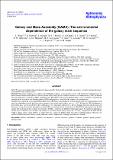Galaxy And Mass Assembly (GAMA) : the environmental dependence of the galaxy main sequence
Abstract
Aims: We aim to investigate if the environment (characterised by the host dark matter halo mass) plays any role in shaping the galaxy star formation main sequence (MS). Methods: The Galaxy and Mass Assembly project (GAMA) combines a spectroscopic survey with photometric information in 21 bands from the far-ultraviolet (FUV) to the far-infrared (FIR). Stellar masses and dust-corrected star-formation rates (SFR) are derived from spectral energy distribution (SED) modelling using MAGPHYS. We use the GAMA galaxy group catalogue to examine the variation of the fraction of star-forming galaxies (SFG) and properties of the MS with respect to the environment. Results: We examine the environmental dependence for stellar mass selected samples without preselecting star-forming galaxies and study any dependence on the host halo mass separately for centrals and satellites out to z ∼ 0.3. We find the SFR distribution at fixed stellar mass can be described by the combination of two Gaussians (referred to as the star-forming Gaussian and the quiescent Gaussian). Using the observed bimodality to define SFG, we investigate how the fraction of SFG F(SFG) and properties of the MS change with environment. For centrals, the position of the MS is similar to the field but with a larger scatter. No significant dependence on halo mass is observed. For satellites, the position of the MS is almost always lower (by ∼0.2 dex) compared to the field and the width is almost always larger. F(SFG) is similar between centrals (in different halo mass bins) and field galaxies. However, for satellites F(SFG) decreases with increasing halo mass and this dependence is stronger towards lower redshift.
Citation
Wang , L , Norberg , P , Brough , S , Brown , M J I , da Cunha , E , Davies , L J , Driver , S P , Holwerda , B W , Hopkins , A M , Lara-Lopez , M A , Liske , J , Loveday , J , Grootes , M W , Popescu , C C & Wright , A H 2018 , ' Galaxy And Mass Assembly (GAMA) : the environmental dependence of the galaxy main sequence ' , Astronomy & Astrophysics , vol. 618 , A1 , pp. 1-6 . https://doi.org/10.1051/0004-6361/201832697
Publication
Astronomy & Astrophysics
Status
Peer reviewed
ISSN
0004-6361Type
Journal article
Collections
Items in the St Andrews Research Repository are protected by copyright, with all rights reserved, unless otherwise indicated.
Related items
Showing items related by title, author, creator and subject.
-
SDSS-IV MaNGA: How the stellar populations of passive central galaxies depend on stellar and halo mass
Oyarzún, Grecco A.; Bundy, Kevin; Westfall, Kyle B.; Tinker, Jeremy L.; Belfiore, Francesco; Argudo-Fernández, Maria; Zheng, Zheng; Conroy, Charlie; Masters, Karen L.; Wake, David; Law, David R.; McDermid, Richard M.; Aragón-Salamanca, Alfonso; Parikh, Taniya; Yan, Renbin; Bershady, Matthew; Sánchez, Sebastián F.; Andrews, Brett H.; Fernández-Trincado, José G.; Lane, Richard R.; Bizyaev, D.; Boardman, Nicholas Fraser; Lacerna, Ivan; Brownstein, J. R.; Drory, Niv; Zhang, Kai (2022-07-06) - Journal articleWe analyze spatially resolved and co-added SDSS-IV MaNGA spectra with signal-to-noise ratio ∼100 from 2200 passive central galaxies (z ∼ 0.05) to understand how central galaxy assembly depends on stellar mass (M*) and halo ... -
Secular-and merger-built bulges in barred galaxies
Mendez Abreu, Jairo; Debattista, V. P.; Corsini, E. M.; Aguerri, J. A. L. (2014-12) - Journal articleContext. Historically, galaxy bulges were thought to be single-component objects at the center of galaxies. However, this picture is now questioned since different bulge types with different formation paths, namely classical ... -
Galaxy And Mass Assembly (GAMA) : galaxy close pairs, mergers and the future fate of stellar mass
Robotham, A. S. G.; Driver, S. P.; Davies, L. J. M.; Hopkins, A. M.; Baldry, I. K.; Agius, N. K.; Bauer, A. E.; Bland-Hawthorn, J.; Brough, S.; Brown, M. J. I.; Cluver, M.; De Propris, R.; Drinkwater, M. J.; Holwerda, B. W.; Kelvin, L. S.; Lara-Lopez, M. A.; Liske, J.; Lopez-Sanchez, A. R.; Loveday, J.; Mahajan, S.; McNaught-Roberts, T.; Moffett, A.; Norberg, P.; Obreschkow, D.; Owers, M. S.; Penny, S. J.; Pimbblet, K.; Prescott, M.; Taylor, E. N.; van Kampen, E.; Wilkins, S. M. (2014-11-11) - Journal articleWe use a highly complete subset of the Galaxy And Mass Assembly II (GAMA-II) redshift sample to fully describe the stellar mass dependence of close pairs and mergers between 10(8) and 10(12)M(circle dot). Using the analytic ...

